The Federal Reserve rate, or “Fed rate”, influences overall interest rates across the board, which in turn could shape the mortgage rates. It impacts how much homebuyers or real estate investors will pay over the loan’s term. Understanding how does the Fed rate affect mortgage rates is crucial to making informed decisions, especially following shifts in the Federal Reserve’s policies like the large Fed cut announced in September 2024.
At Defy Mortgage, we provide over 75 traditional and non-traditional financing solutions. Our expertise includes DSCR loans, HELOCs, bank statement loans, and more. Whether you’re an entrepreneur, freelancer, or real estate investor, we can provide fast and reliable solutions fully customizable to fit your unique needs.
As mortgage industry experts, we closely track how the Fed rate affects mortgage rates to better serve our clients. In this blog, we’ll explore the mechanisms behind the Fed rate’s effect on mortgage rates and explain what the recent Fed interest rate cuts mean for borrowers from 2024 to the next year.
Let’s dive in.
The Effects of the Fed Rate on Mortgage Rates
To understand how does the Fed rate affect mortgage rates, we need to first grasp what the Fed rate is. The Fed rate is how the Federal Reserve influences borrowing costs for banks, which impacts other forms of debt, like mortgages.
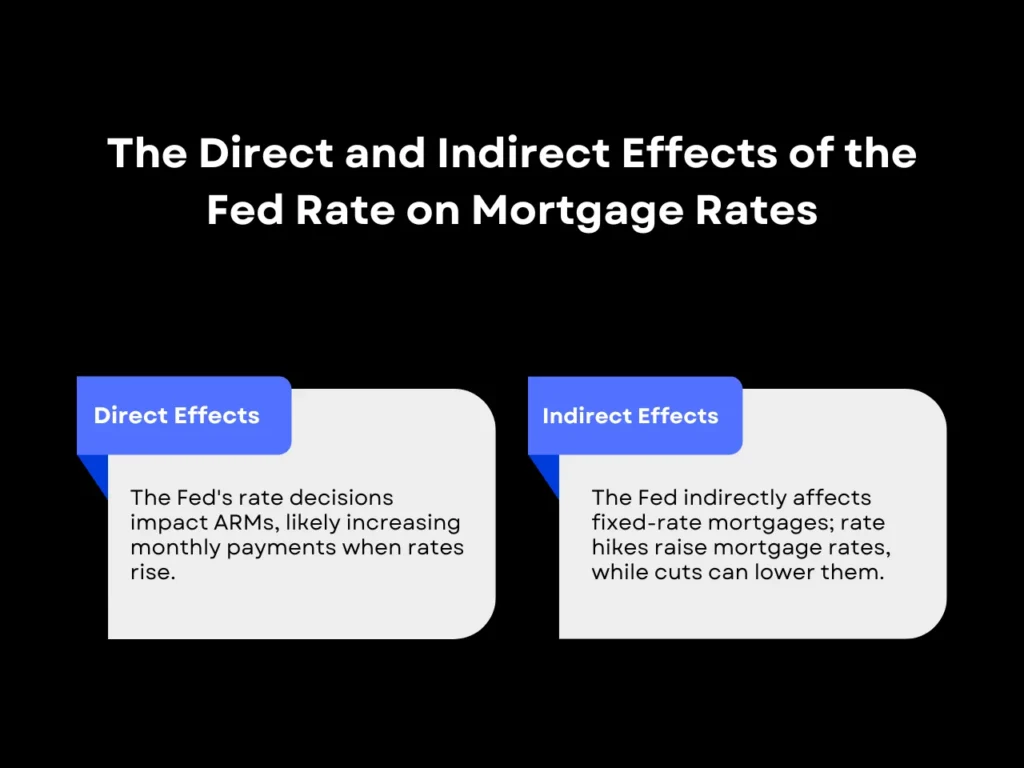
Indirect Effects
Although the Fed does not directly control mortgage rates, its short-term interest rate decisions can have a profound effect on adjustable-rate mortgages (ARMs). ARMs are more sensitive to fluctuations in the Fed rate as they may adjust their rates more frequently based on the benchmark rate, market indices like the Federal Cost of Funds Index (COFI), and general market conditions. When the Fed raises rates, ARMs can follow suit, leading to higher monthly mortgage payments for borrowers with adjustable-rate loans. However, this isn’t always the case.
It’s important to remember that The Federal Reserve’s benchmark rate and mortgage rates, while connected, follow distinct paths. Though mortgage rates respond to multiple factors like market conditions and various financial indicators, changes in the Fed funds rate often signal their general direction. This relationship makes the Fed rate a helpful compass for anticipating mortgage rate trends, even though it’s not a direct determinant of what homebuyers ultimately pay.
The true driving force behind mortgage rates is actually the 10-year Treasury yield, along with a complex web of economic factors. These include how the market views future inflation, the overall state of the economy, and conditions in the housing sector.
For the vast majority of mortgages, which have fixed rates, the Fed’s influence is also connected, but not directly correlated or indicative of changes. Mortgage lenders set their rates based on long-term Treasury yields, which move in response to expectations about the economy and inflation.
When the Fed raises rates to cool inflation, Treasury yields often rise, which pushes mortgage rate higher. A higher Fed rate signals that the economy is currently experiencing inflation, leading investors to seek greater returns on Treasury bonds to offset the diminishing value of each dollar. Since mortgage-backed securities typically span 30 years compared to the 10-year maturity of Treasury bonds, they need to offer better returns. This forces mortgage rates to increase in order to remain attractive to investors seeking higher yields.
Conversely, Treasury yields may fall following Fed interest rate cuts, which could have the opposite effect on mortgage rates as lower borrowing costs can make longer-term debt more attractive to investors. This allows lenders to have lower mortgage rates to encourage more investment in real estate.
Keep in mind, however, that investor outlook is a critical factor as well. The mere expectation of future inflation can drive up demand for Treasury yields, indirectly causing mortgage rates to rise. These includes situations such as when the Fed Rate is lowered amid excessive money supply or when economic instability creates uncertainty about long-term inflation.
Mortgage Types and How They React to Fed Rate Changes
Mortgages can be categorized into two main types, which react to Fed funds rate changes differently. Understanding how these variations work can help you choose the right mortgage type based on the economic outlook for 2024.
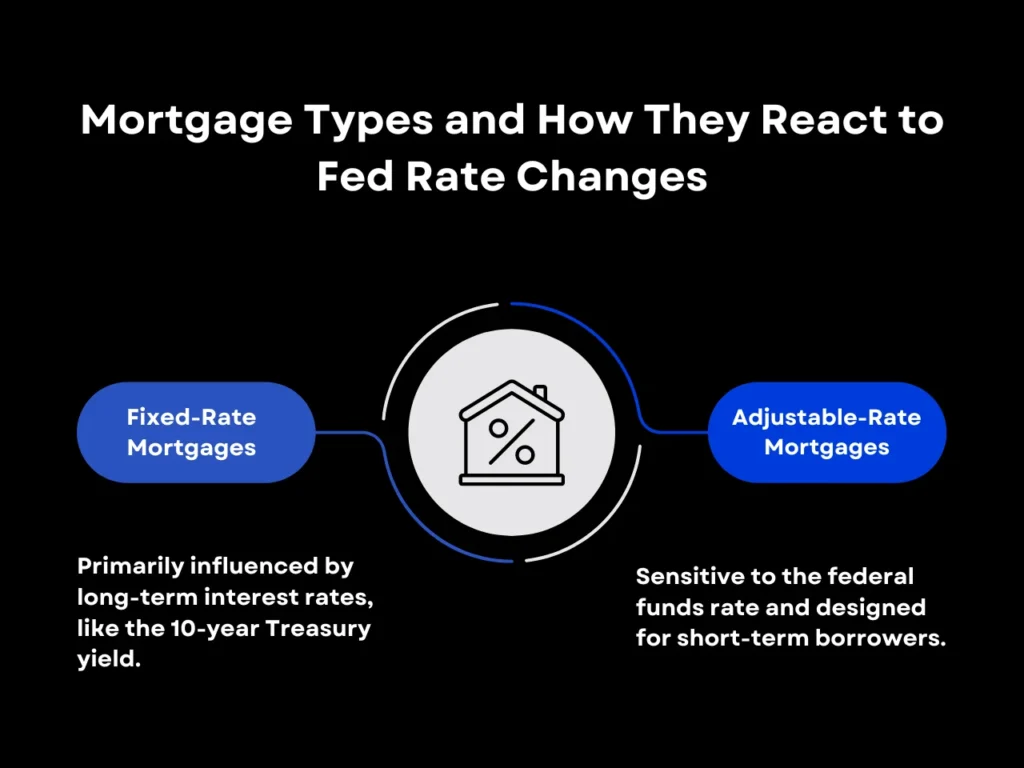
Fixed-Rate Mortgages
Fixed-rate mortgage rates are more directly influenced by long-term interest rates, such as the yield on the 10-year Treasury note. As discussed earlier, high inflation demands higher Treasury returns so investors can get their money’s worth, which forces mortgage-backed securities to raise their own rates to attract their own investors.
However, during economic uncertainty, demand for safe investments like U.S. Treasuries rises, which can lower yields and, in turn, mortgage rates. Even when the Fed raises rates, fixed-rate mortgages remain relatively stable in the short term as they are more influenced by long-term economic outlook.
Fortunately, one of the foremost advantages of fixed-rate mortgages is their locked-in rate at closing, making them particularly appealing when interest rates are low. This stability provides borrowers with predictable payments, regardless of future rate hikes.
Adjustable-Rate Mortgages (ARMs)
By design, this type of mortgage is more sensitive to the federal funds rate. Adjustable-Rate Mortgages are favored by borrowers planning to hold the loan for a shorter period, such as those pursuing Fix-and-Flip loans or leveraging a short-term rental DSCR loan during a tourism spike. However, unlike fixed-rate mortgages, ARMs carry the risk of increased interest payments if the federal funds rate rises, making them more volatile in response to rate hikes.
What to Expect in 2025
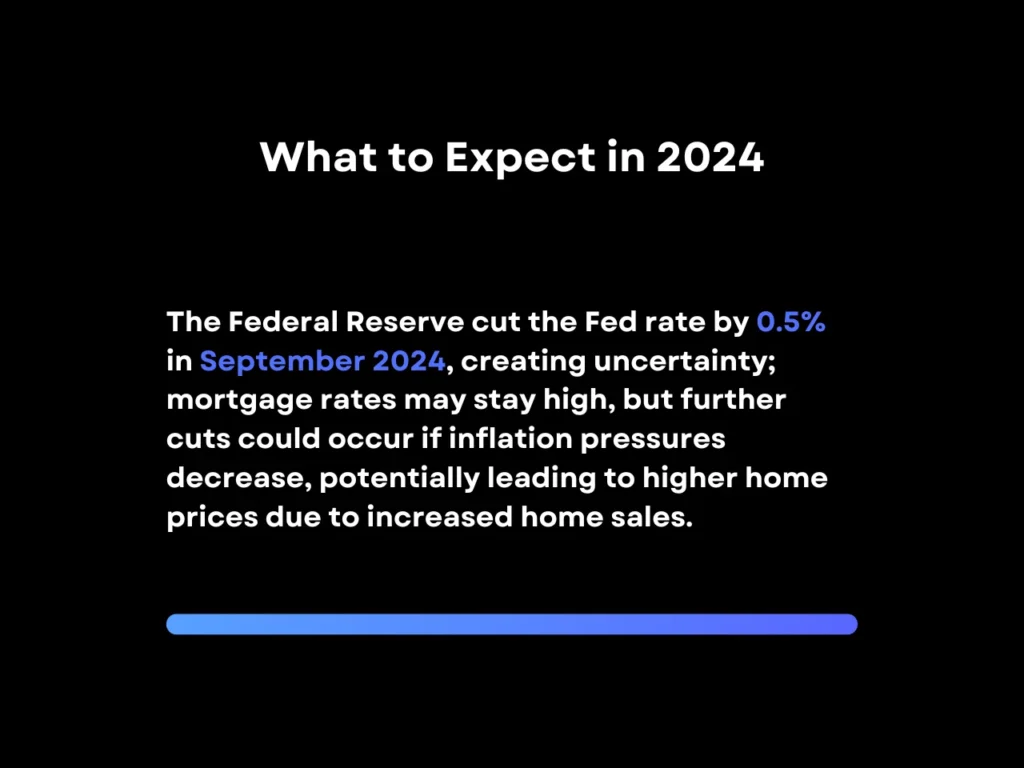
Following the September 2024 Fed meeting, the Federal Reserve cut the Fed rate by 50 basis points or 0.50%, stirring uncertainty surrounding the future trajectory of the Fed rate. With inflation still a concern, mortgage rates may remain elevated as investors proceed cautiously.
However, many economists predict more cuts to the Fed rate if inflation eases through the end of the year. One of the prevailing theories is that the Fed will cut the rate by 25 basis points in both November and December for a total cut of 100 bps by the end of the year. Some even predict that 75 bps will be cut by December’s end for a total cut of 1.25% going into 2025.
Depending on how accurate these predictions are, the mortgage market could see volatility, as the Fed fine-tunes adjustments to the Fed rate to match overall market conditions, or a downward mortgage rate trend, at least for a time. However, if the rate gets cut further as the economy grows, it could potentially result in higher home prices due to increased home sales diminishing available inventory in the housing market. This isn’t a given, but something to keep in mind.
Economic Forecasts
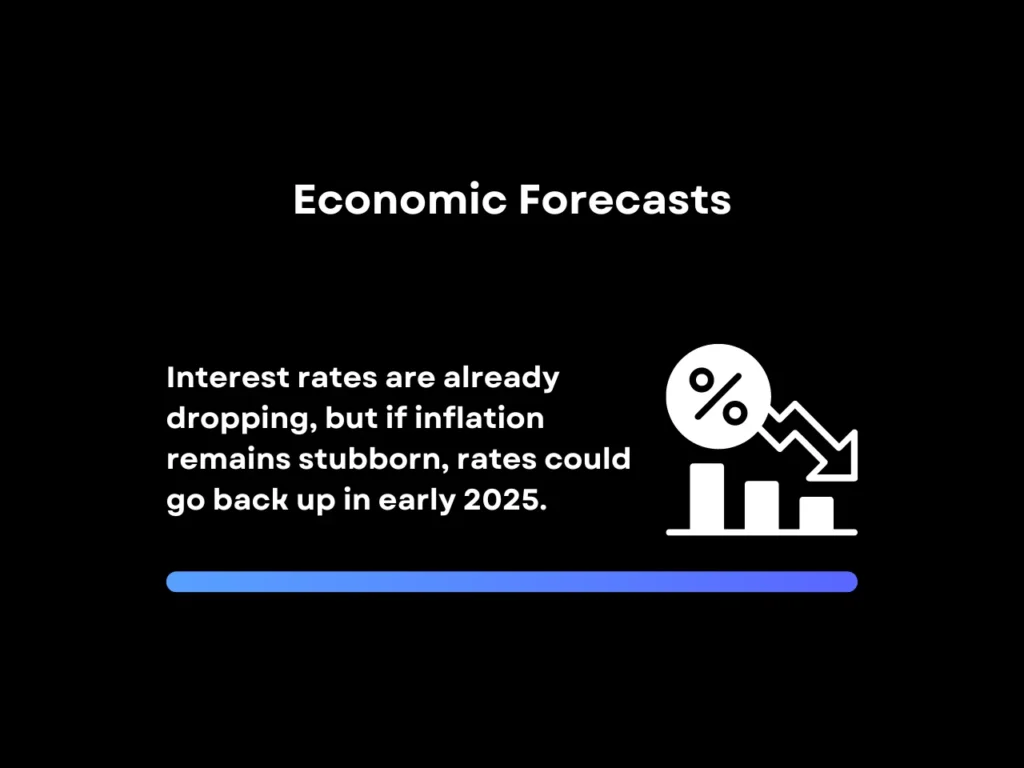
For those wondering “when will interest rates drop?”, the answer is: they already started dropping on the lead-up to the September meeting of the Federal Open Market Committee. Refinance activity rose sharply during this period, but interest rates picked back up again 3 weeks later. Should the Fed continue cutting rates, mortgage rates may be back on a steady decline by mid-2025. However, if inflation persists, analysts warn average rates could go back up by early 2025.
Given economic uncertainties, timing will be difficult for homebuyers and investors, so monitoring inflation and Fed decisions closely will be key. Housing supply continues to be an issue, and mortgage demand is at a 30-year low at only 25 out of 1000 homes being sold between Q1-Q3 2024, down from the previous low of 28 out of 1000 homes in 2023.
This is a strong indicator that would-be homebuyers are waiting for the Fed rate to fall further before purchasing or refinancing. And sure enough, new mortgage applications increased by 14.2 percent following the Fed rate cut, with larger spikes likely to follow if the Fed rate continues on a downward trajectory.
If you’re looking to buy or refinance, remember to stay informed about Fed announcements to ensure that their timelines align with future developments in Fed policy. This will allow you to close ahead of potential housing shortages following large spikes in demand, which, apart from limiting your choices, can also drive mortgage rates back up.
Likewise, it’s important to remember that rates can change, so if you purchase at a certain rate, there will always be an opportunity to refinance.
Refinancing and Purchasing After a Federal Reserve Rate Cut: Is It Right for You?
When the Federal Reserve lowers interest rates, refinancing your mortgage can be a prudent financial decision, though its suitability depends on your individual circumstances and current market conditions. If your existing mortgage rate significantly exceeds current rates, refinancing could potentially:
- Reduce your monthly payments
- Decrease the total interest paid over the loan’s lifetime
- Allow you to switch from an adjustable-rate to a fixed-rate mortgage for payment stability
- Provide access to your home’s built-up equity through cash-out refinancing
Cash-out refinancing offers additional opportunities, such as:
- Using equity from one investment property to fund the down payment on another
- Consolidating high-interest debts
- Investing in your future
However, it’s essential to carefully evaluate your specific situation before deciding to refinance.
If you’re contemplating a property purchase, it may be advantageous to act swiftly following a rate cut depending upon the market conditions and your individual situation. Here’s why:
- Anticipated increase in market activity: Lower rates often lead to higher demand.
- Current favorable rate environment: Take advantage of potentially lower borrowing costs.
- Portfolio growth opportunities: Expand your real estate holdings before increased competition potentially drives up prices.
- Maximizing ROI: Secure properties at potentially lower costs and with more favorable financing terms.
By moving quickly, you may be able to capitalize on these opportunities before heightened demand intensifies market competition. Keep in mind that everyone’s financial situation is different, so before you make any decisions, consult with your financial advisor and lender.
How Does the Fed Rate Affect Mortgage Rates FAQs
Will Mortgage Rates Increase if the Fed Raises Rates in 2025?
Yes, if the Fed raises rates, adjustable-rate mortgages (ARMs) will likely increase because they directly respond to short-term interest rate changes. Fixed-rate mortgages may also rise indirectly, as long-term Treasury yields, which influence these rates, tend to follow the Fed’s actions. However, this shift may not be immediate and could depend on investor expectations and economic conditions.
Why Don’t Mortgage Rates Always Follow the Fed Rate Exactly?
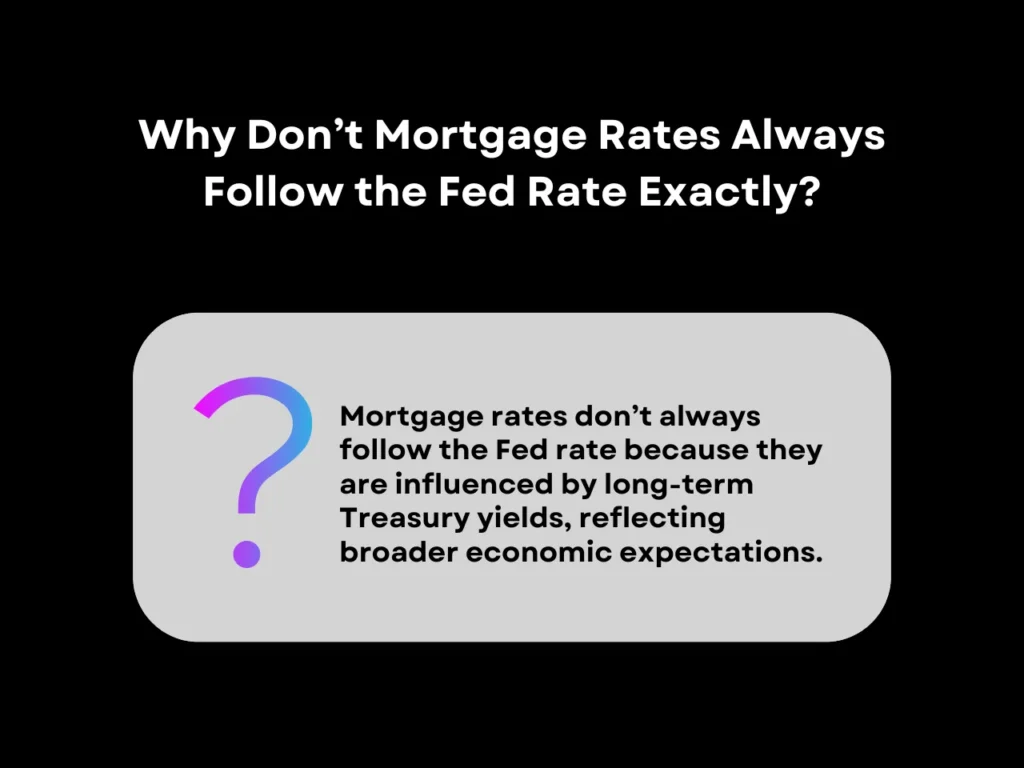
Mortgage rates are primarily driven by the bond market, particularly long-term financial products like Treasury yields. While the Fed rate affects short-term borrowing costs, fixed-rate mortgages are more influenced by factors like inflation expectations, global economic conditions, and investor sentiment. Therefore, mortgage rates may not mirror Fed rate changes exactly, but they are indirectly impacted over time.
How Does Inflation Affect the Relationship Between the Fed Rate and Mortgage Rates?
When inflation is high, the Fed raises rates to curb it, making borrowing more expensive. This causes mortgage rates, particularly fixed-rate loans tied to long-term yields, to rise as well. Investors demand higher returns on long-term investments, like Treasury bonds, to offset the erosion of purchasing power caused by inflation, which pushes up mortgage rates.
Should I Get a Fixed or Adjustable-Rate Mortgage in 2025 Based on the Fed Rate Predictions?
If you expect the Fed to cut rates even further, an adjustable-rate mortgage (ARM) might offer lower initial payments, especially if mortgage rate predictions foresee a trend of lower rates. However, if you want more stability in a potentially volatile market, a fixed-rate mortgage provides more certainty by locking in the rate throughout the loan term, protecting you from future rate increases.
How Soon After the Fed Changes the Rate Will Mortgage Rates Adjust?
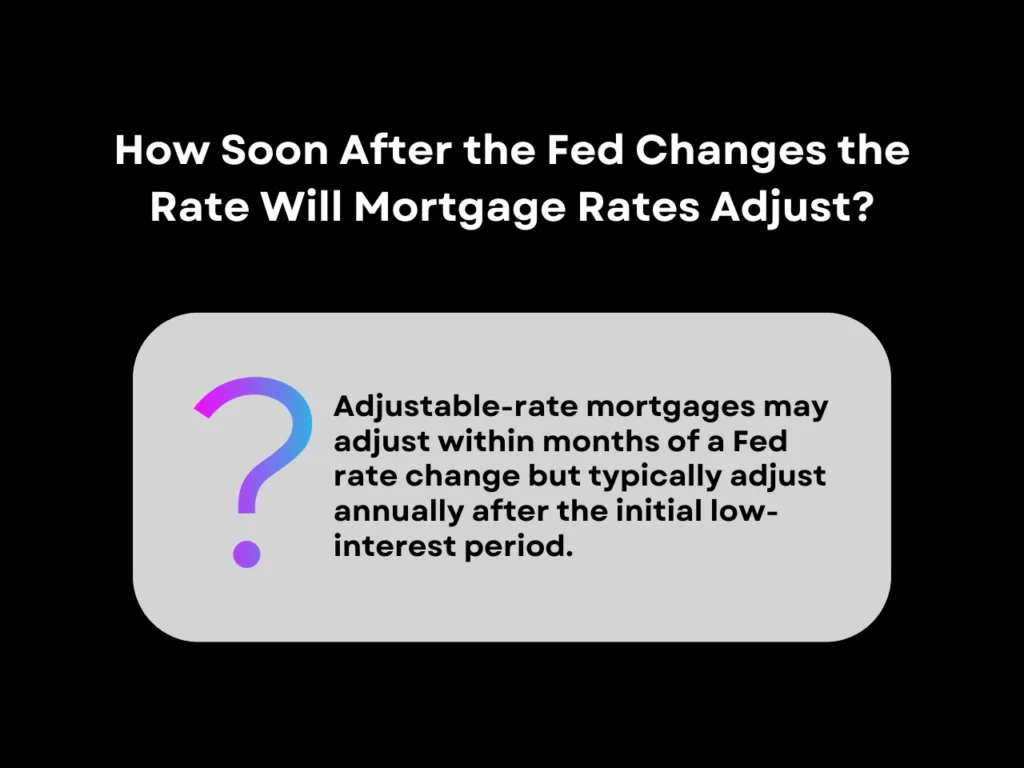
Adjustable-rate mortgages (ARMs) may respond to Fed rate changes within a few months, depending on the loan’s adjustment schedule, but not always. Typically, ARMs adjust annually after the initial low-interest period. Fixed-rate mortgages, on the other hand, are influenced by long-term bond yields and may adjust more gradually based on broader economic trends rather than immediate Fed rate changes.
Key Takeaway
The question of how does the Fed rate affect mortgage rates involves several factors. While the Fed rate impacts short-term rates directly, its influence on mortgage rates is more complex, driven by Treasury yields and market conditions. Homeowners, entrepreneurs, and real estate investors should closely monitor inflation trends, Fed announcements, and bond market fluctuations to make informed mortgage decisions.
If you’re considering locking in a mortgage rate or refinancing, timing is critical. Securing a rate during low inflation or after Fed interest rate cuts could save significant costs over time. Stay proactive by evaluating the broader economic outlook, as Treasury yields and investor sentiment can also affect mortgage costs.
Need expert advice on your next mortgage strategy? Schedule an appointment with Defy today for personalized assistance on your mortgage strategy. Whether it’s a fixed-rate mortgage or adjustable-rate home equity loan, our experts can tailor solutions to help you navigate the shifting economic landscape.




